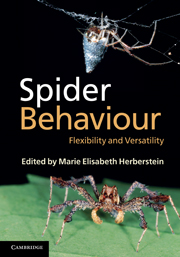Book contents
- Frontmatter
- Contents
- List of contributors
- How this book came about
- 1 Introduction: spider biology
- 2 Flexibility in the foraging strategies of spiders
- 3 Spider webs: evolution, diversity and plasticity
- 4 Flexible use of anti-predator defences
- 5 Communication
- 6 Deceptive signals in spiders
- 7 Mating behaviour and sexual selection
- 8 Group living in spiders: cooperative breeding and coloniality
- 9 Plasticity, learning and cognition
- 10 Kleptoparasitic spiders of the subfamily Argyrodinae: a special case of behavioural plasticity
- Index
- Plate section
- References
8 - Group living in spiders: cooperative breeding and coloniality
Published online by Cambridge University Press: 05 June 2012
- Frontmatter
- Contents
- List of contributors
- How this book came about
- 1 Introduction: spider biology
- 2 Flexibility in the foraging strategies of spiders
- 3 Spider webs: evolution, diversity and plasticity
- 4 Flexible use of anti-predator defences
- 5 Communication
- 6 Deceptive signals in spiders
- 7 Mating behaviour and sexual selection
- 8 Group living in spiders: cooperative breeding and coloniality
- 9 Plasticity, learning and cognition
- 10 Kleptoparasitic spiders of the subfamily Argyrodinae: a special case of behavioural plasticity
- Index
- Plate section
- References
Summary
Group living occurs in two different forms in spiders, cooperatively breeding social species and colonial species. The social species construct a communal nest and capture web, capture prey and feed together and cooperate in raising the young. Social spiders lack pre-mating dispersal, which results in regular inbreeding within colonies. Social species are thought to be derived from subsocial forms, which have lengthy maternal care and some cooperation among young, but pre-mating dispersal of juveniles limits inbreeding. There are currently only 25 known social species occurring in seven different families and representing perhaps 19 independent evolutionary transitions to sociality. Colonial group living is much more common and occurs in a wide range of forms, from short-lived or long-lived aggregations of web-building spiders to communal nesting of active hunting species. Colonial species generally do not cooperate in prey capture and feeding, though there are exceptions; they do not cooperate in brood care; they have pre-mating dispersal and are outbred. Coloniality is likely derived from aggregation at rich food sources or nesting sites. Cooperation in the colonial species takes the form of sharing silk structures such as frame threads and nesting sites. The benefits of close proximity include the capture of larger prey and reduced variance in prey amount per spider and early warning of the presence of predators or parasites. However, group living carries costs of greater visibility both to potential prey and to predators and parasites. These benefits and costs are similar in cooperative-breeding and colonial species, while the main differences between them lie in degree of cooperation and the mating and breeding systems.
- Type
- Chapter
- Information
- Spider BehaviourFlexibility and Versatility, pp. 275 - 306Publisher: Cambridge University PressPrint publication year: 2011
References
- 24
- Cited by

